This authentic Kerala chicken curry recipe captures the essence of the popular South Indian dish known as ‘nadan kozhi.’ This easy curry is made with bone-in or boneless chicken pieces and a medley of spices and is fragrant, mildly spicy, and creamy.
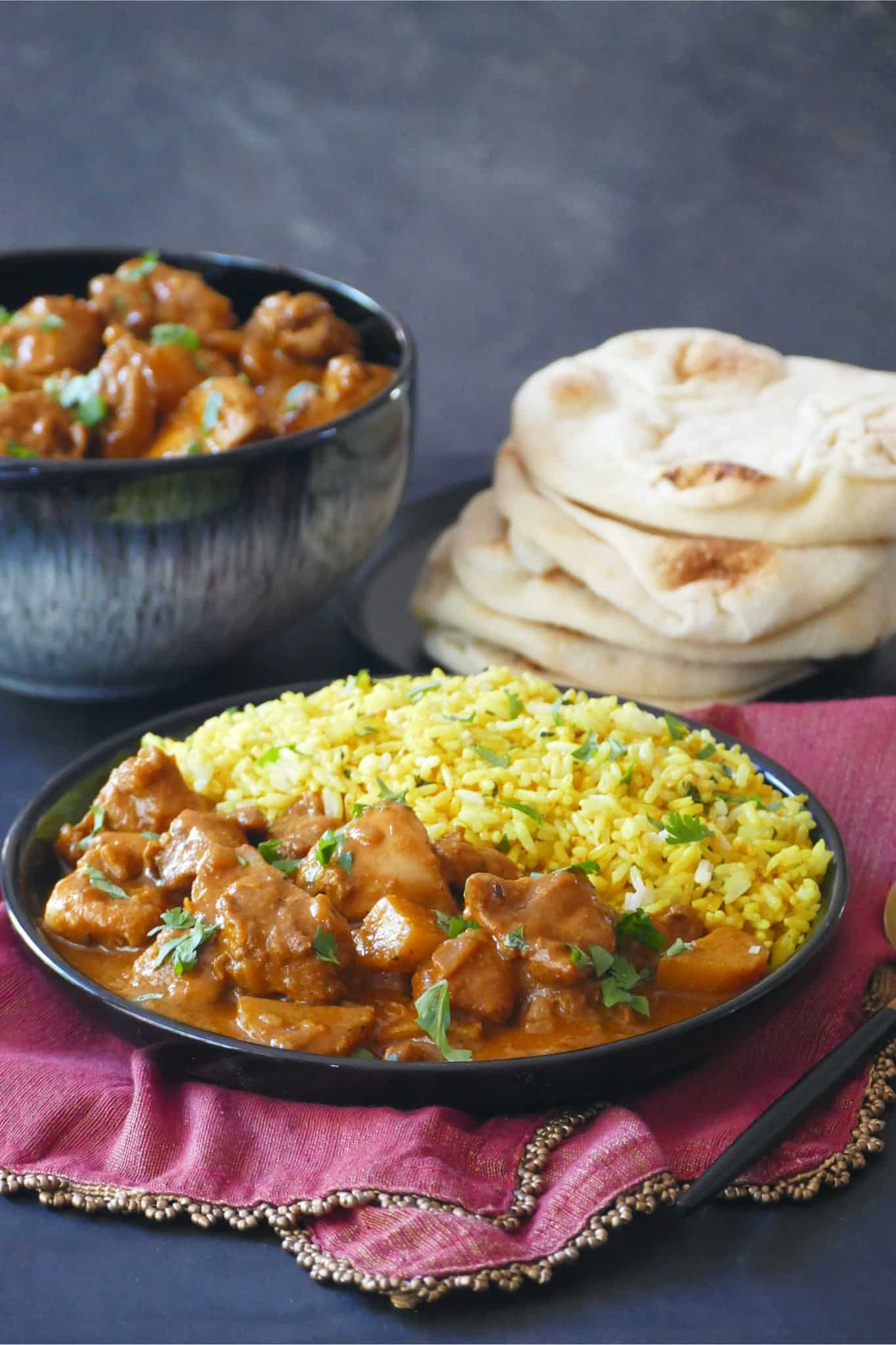
This post contains affiliate links. As an Amazon Associate, I earn from qualifying purchases. Please read the disclosure.
🌏 What is Kerala Chicken Curry?
Kerala is a state on the Southwestern tip of India famous for its beautiful coconut tree-lined backwaters and spice-covered hills. This diverse region is where my family hails from and where I fondly remember spending a part of my childhood.
Kerala cuisine features flavorful curries made with different blends of spices that create unique recipes. Coconut and fresh curry leaves are common in many recipes. I may be biased, but I think Kerala cooking is the best!
Kerala-style chicken curry is also called ‘nadan kozhi’. ‘Nadan’ (pronounced ‘nah-done’) means ‘from the land (or homeland)’ and ‘kozhi’ (pronounced ‘koh-rhee’) means ‘chicken.’
This recipe I grew up with is one of my favorite recipes. It is my mom’s recipe for authentic Kerala style chicken curry with potatoes. Pretty much anyone who tries it asks her for the recipe.
➡ Looking for more Kerala recipes? Try my chicken korma, chicken 65, Kerala egg curry, parippu curry, Kerala vegetable stew, or sambar recipe. You’ll love them as much as I do!
Every household has its own version of chicken curry. Mom’s original recipe is made with bone-in chicken, which tastes amazing, but you can use boneless chicken too.
Traditional Kerala chicken curry has mustard seeds, curry leaves, and fennel seeds, but I occasionally make this curry omitting these ingredients, and it still tastes great.
The optional ingredient here is potatoes. I love the heartiness of the curry with the potatoes but you can choose to omit them or add other vegetables of your choice.
This recipe can also be made in the Instant Pot. For more Indian favorites, try my Instant Pot Chicken Curry, Instant Pot lamb curry, or Instant Pot beef curry recipe! And if you’re looking for a modern fusion twist on chicken curry, try my chicken curry soup.
To complete the meal, serve it with Indian bread (naan), appam (rice pancakes), plain rice, or ghee rice (rice cooked with whole spices and ghee).
❤️ WHY YOU SHOULD TRY THIS KERALA CHICKEN CURRY WITH POTATOES
- This simple chicken curry recipe has been perfected over many generations.
- The curry uses individual spices that give it a unique flavor that curry powder just can’t replicate.
- The chicken curry base is sauteed onions cooked to a deep golden brown, enhancing the curry’s flavors.
- The Kerala curry is versatile, and you can customize it by changing or omitting hard-to-find ingredients like curry leaves or substituting the potatoes with your choice of vegetable.
🧂 Ingredients You’ll Need for Kerala Chicken Curry
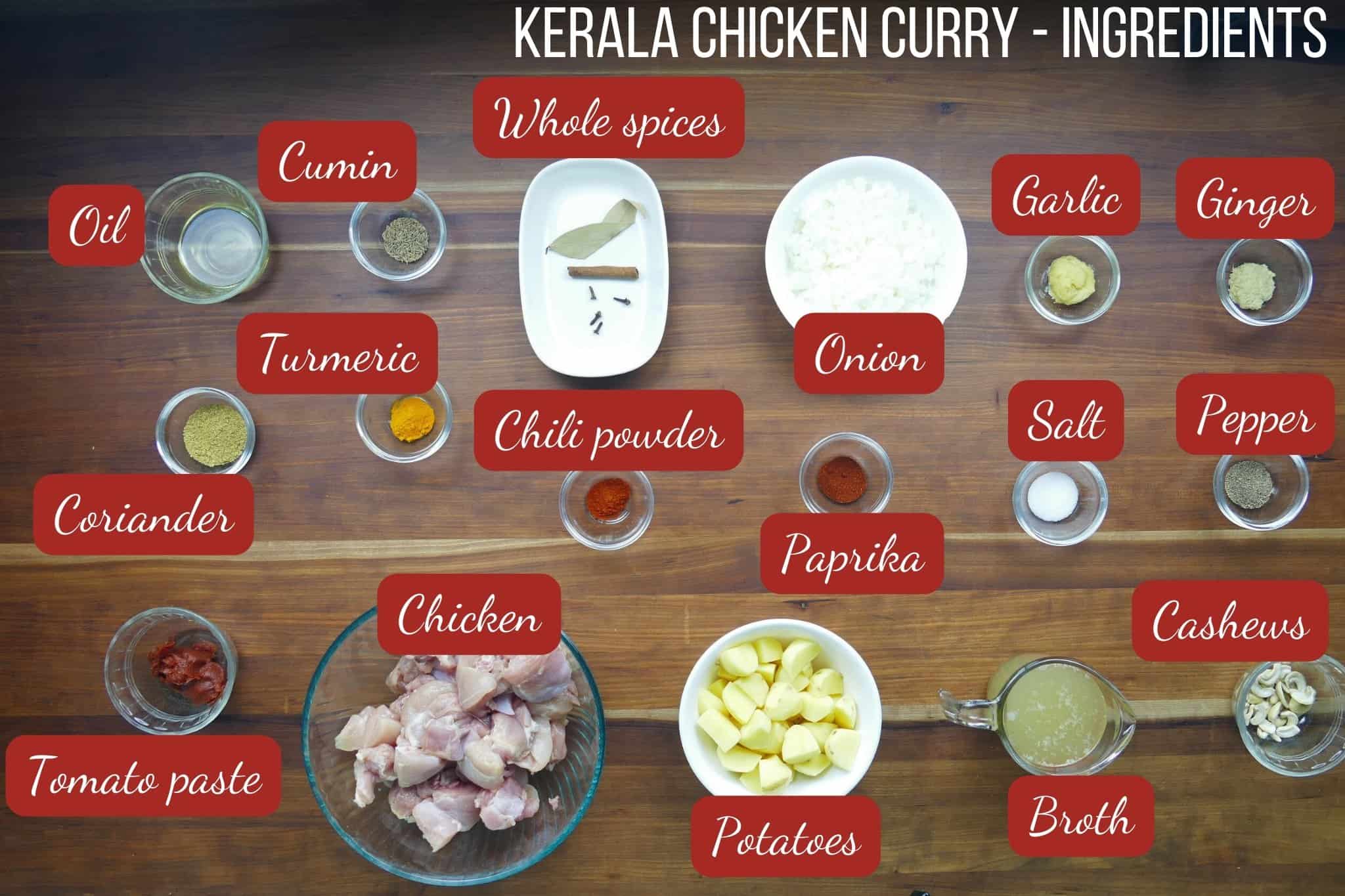
- Coconut oil is traditionally used in Kerala cooking, but vegetable oil works well too. You can also substitute ghee – use my recipe for Instant Pot ghee.
- Whole spices are also known as whole garam masala. They can include cinnamon sticks, bay leaves, cloves (not garlic cloves!), and cardamom. The above photo doesn’t include cardamom, but you can add them.
- Yellow onions or red onions can be used. Red onions have a stronger flavor.
- Ginger garlic paste can be used instead of minced ginger and garlic.
- Kashmiri chili powder is a milder Indian chili powder. If you want the curry to be even milder, substitute any part of the chili powder with paprika.
- Tomato paste can be substituted with two medium finely chopped tomatoes (you can also coarsely blend them). Cook them until they break down.
- Potatoes are optional, but I like to include them. They make the curry hearty and increase the food quantity if you’re serving a larger group.
- Cashew paste is made by grinding a handful of cashew nuts and water into a very fine paste (not grainy). You can also use coconut cream or thick coconut milk to finish the curry. This step is optional.
The following ingredients are optional but add an authentic flavor.
- Black mustard seeds are sputtered in hot oil before adding the whole spices.
- Fennel seeds are a common spice in Kerala cuisine. Add half a teaspoon with the other spices. You can use whole fennel seeds or fennel powder.
- Curry leaves may not be easily available to you, so I’ve made them optional.
Quantities and details are provided in the recipe card at the bottom of this post
💡 Ingredient and Recipe Tips
Here are some tips for getting the best results when making South Indian chicken curry:
- Use bone-in chicken instead of boneless – Boneless is quicker but I think bone-in chicken tastes better! Increase the cooking time and check for doneness.
- Use good quality, fresh spices – If your spice powders have been sitting in your cabinet for years, do yourself a favor and toss them. Fresh ingredients make a better curry. I toast whole coriander and cumin seeds and grind them in a spice grinder.
- Marinate the chicken – If time allows, rub the chicken pieces with the spices for 30 minutes; in other words, after sauteing the tomatoes, add the marinated chicken pieces to the onion and tomato mixture. This allows the flavors to penetrate fully and ensures tender, flavorful meat.
- Brown the onions really well – Properly browning the onions caramelizes their natural sugars and adds color and flavor to the base. Cook over medium heat till the onions turn a rich golden brown. If you know you’ll be short on time, brown the onions ahead of time and store them in the fridge until you’re ready to make the curry.
- Simmer the curry slowly – The chicken should be braised and simmered on medium-low to low heat in the sauce to make it tender. Don’t rush the cooking process. Allow time for the flavors to meld. The chicken is usually done when the potatoes are done.
- Customize spice levels – Adjust the spiciness by varying the amount of chili powder or substituting all or some of the Kashmiri chilli powder with paprika. You can also add chopped green chillies to give the curry more heat.
- Add curry leaves – Fried curry leaves are essential to Kerala cooking and are available at many South Asian grocery stores. Sadly, these leaves are not easily accessible to many Western cooks. If you can get fresh ones (don’t use dried curry leaves), briefly fry about ten leaves in the hot oil while you’re sauteing the whole spices.
- Use coconut oil – Substitute vegetable oil with coconut oil to give the curry an authentic Kerala taste. Or drizzle a little coconut oil on top of the cooked curry to give it an extra dose of flavor.
- Finish with cashew paste or thick coconut milk – Make chicken curry with coconut milk by adding it right at the end to give the curry a slightly sweet and creamy taste. Or blend cashew nuts with water into a very fine paste and add to the curry. Simmer just until heated through. The curry tastes great even without coconut milk or cashew paste.
- Serve with appam, white rice, ghee rice, or naan – The curry is traditionally served with appam (rice pancakes) or rice to soak up the flavorful gravy. Rice dishes like ghee rice or coconut rice complement it well, too.
- Let the chicken curry rest for a day – This Indian chicken curry, like many Indian curries, tastes even better the next day.
✅ Why Trust Neena at Paint the Kitchen Red?

I’m Neena, and I’ve spent a lifetime perfecting the recipes I share. My years of practice have honed my skills, resulting in consistently delicious and easy meals. My experience (including hits and misses!) enables me to provide valuable insights, troubleshooting advice, and innovative recipe ideas. Every recipe is tested multiple times, so you can be sure it works the first time!
❓ FAQS
If you can grind your own garam masala, that would be the best option. If you’re using store-bought garam masala, make sure it isn’t old. Try my homemade Kerala garam masala recipe.
Chicken thighs have more flavor and are best for Indian cooking, however, you can use chicken breasts if you wish. You need to watch out not to overcook it.
Add coconut milk to the curry to make it less spicy. Start with a couple of tablespoons and add more to taste.
📝 How to Make Nadan Chicken Curry
- Saute onions
- Saute tomato paste and add the chicken
- Thicken the curry
Saute Onions
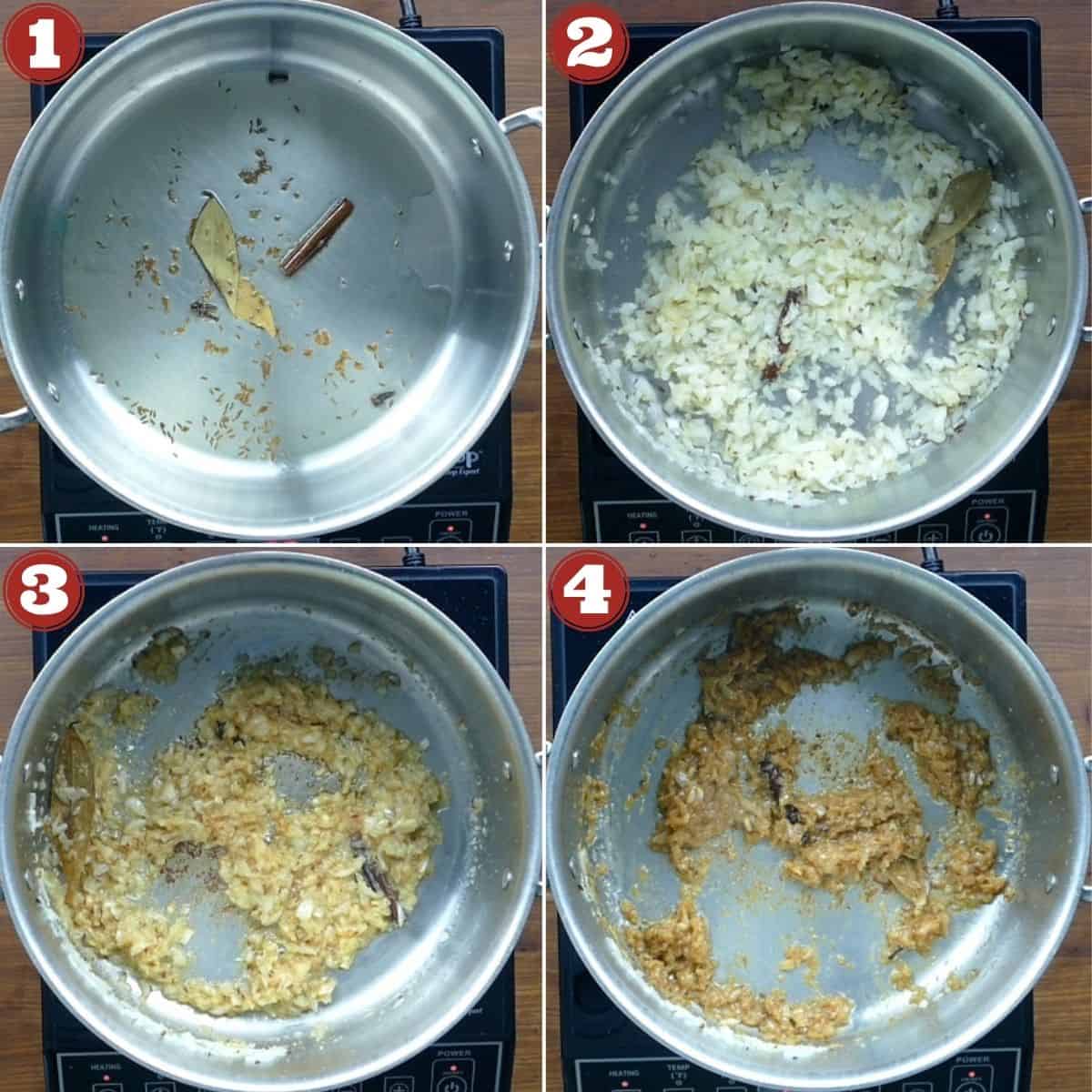
- Add two tablespoons of coconut oil or vegetable oil to a large saute pan or dutch oven. Once the oil is hot, add the mustard seeds (if using) and cover. Once the mustard seeds have popped, lower the heat to medium and add bay leaf, cinnamon, cloves, cumin seeds, and curry leaves (if using).
- Immediately add onion, garlic, and ginger (or ginger-garlic paste).
- Stir frequently. Lower the heat if necessary to ensure onions caramelize and don’t burn.
- Fry well until deep golden brown. This process can take up to 20 mins. See tip below.
✏️ PRO TIP FOR BROWNING ONIONS QUICKLY
- To speed up the browning of the onions, increase the heat to medium-high. When the onions start sticking to the bottom and getting brown, deglaze with a tablespoon or two of water or chicken broth.
- Scrape up the brown bits (fond) and incorporate them back into the onion mixture.
- Keep doing this until the onions are a deep golden brown but not burnt! You need to watch them closely because they can burn easily at higher temperatures.
Saute tomato paste and add the chicken
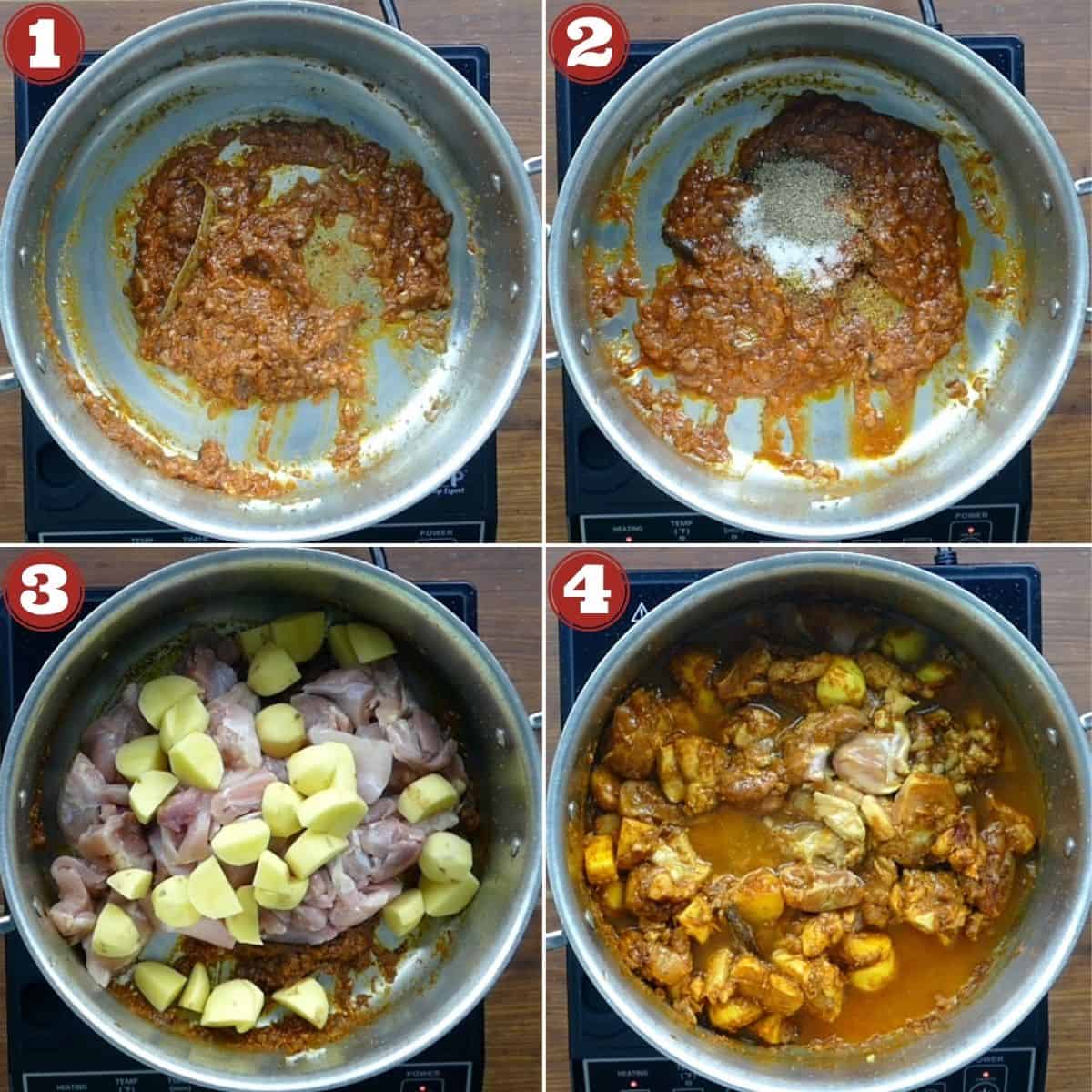
- Once the onions are browned, add tomato paste and a tablespoon of hot water. Cook the tomato paste, stirring frequently. Cook until the oil separates, about 5 minutes. Add a few teaspoons of hot water if the mixture starts sticking to the bottom of the pan.
- Add the spices and mix well, till fragrant, about 20 to 30 seconds. *
- Add the potatoes and chicken and mix to coat with the onion mixture until the chicken begins to lose its pink color and begins to brown.
- Stir in hot water and chicken broth. Lower heat to low or medium-low and cover with a lid and cook. Simmer for 20 to 30 minutes or till the chicken is done and the potatoes are soft, stirring occasionally. If the curry is too thick or sticks to the bottom of the pan, add some more water as needed.
* If you have the time, marinate the chicken with the spices for 30 minutes to a few hours and add marinated chicken to the pan instead of adding spices and chicken separately.
Thicken the curry
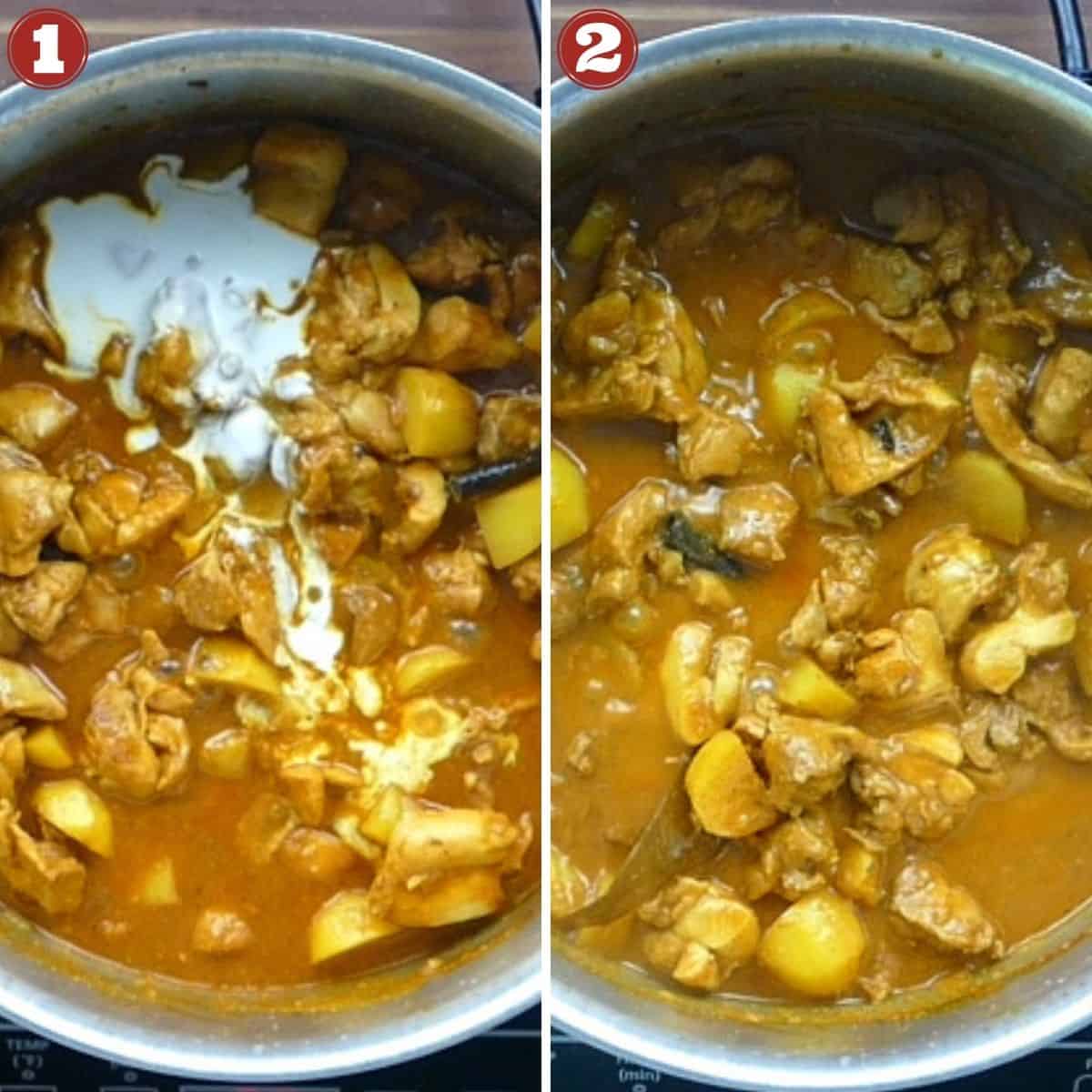
- Once the chicken and potatoes are cooked, add some cashew paste or coconut milk to thicken and mellow the curry. This is an optional step – the curry tastes great without it, too.
- Sprinkle the chicken with garam masala and heat through. Fry some curry leaves in coconut oil and drizzle over the top if you have access to curry leaves.
More Chicken Recipes
- Curry pasta is my Indian spin on pasta. The one-pot pasta recipe has the flavors of chicken tikka masala and is a must-try!
- Try making pot in pot brown rice using the PIP method for smaller quantities of rice and easy cleanup.
- Arroz con Pollo is a Latin chicken and rice easy recipe that always comes out perfect.
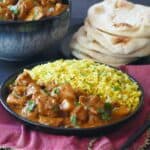
Kerala Chicken Curry
Ingredients
- 3 tablespoon vegetable oil or coconut oil
- 1 teaspoon black mustard seeds
- 1 bay leaf
- 2 inch cinnamon stick
- 3 to 4 whole cloves
- ½ teaspoon cumin seeds
- 10 curry leaves (optional)
- 2 onions chopped fine (about 2 cups)
- 1 tablespoon garlic minced
- 1 tablespoon ginger minced
- 2 tablespoon tomato paste
- 1 tablespoon coriander powder
- ½ teaspoon turmeric powder
- ¾ teaspoon black pepper powder
- 1 teaspoon Kashmiri chili powder or to taste
- 1 teaspoon paprika
- 1 teaspoon salt
- ½ teaspoon fennel seeds
- 2 lbs boneless skinless chicken thighs cut into 1 ½ pieces or bone-in chicken thighs (skinless) – 1 kg
- 2 cups potatoes cut into 1 ½ inch cubes (optional) *
- ½ cup hot water
- ½ cup low sodium chicken broth or water
- 1 tablespoon cashews or coconut cream (optional)
- 1 teaspoon garam masala
- ¼ cup cilantro chopped
- 2 teaspoon coconut oil optional
- 10 curry leaves optional
Instructions
- Heat 2 tablespoon oil over medium-high heat in a large saucepan or dutch oven.
- When oil is very hot, add mustard seeds and immediately cover the pan, allowing the mustard seeds to pop.
- Lower heat to medium and remove cover. Add bay leaf, cinnamon, cloves, cumin seeds, and curry leaves.
- Immediately add onion, garlic and ginger; fry well until deep golden brown. Lower the heat if necessary, to make sure onions caramelize and don’t burn. Stir frequently. This process can take up to 20 minutes.
- Add remaining 1 tablespoon oil, then add tomato paste and fry, stirring frequently.
- Cook until the oil separates and the mixture becomes paste-like, about 5 minutes; Add a bit of hot water if the mixture starts sticking to the bottom of the pan.
- Stir in coriander, turmeric, black pepper, chili powder, paprika, salt, and fennel seeds (if using). Fry briefly till fragrant, about 20 seconds. **
- Increase heat to medium-high and add chicken and potatoes (if using) and stir to coat.
- Fry until chicken pieces lose their pink color and start to lightly brown.
- Stir in hot water and chicken stock, cover, and cook. Simmer for 20 to 30 minutes or until chicken is cooked and potatoes are soft, stirring occasionally. If curry is too thick or sticks to the bottom of the pan, add some more broth or water as needed.
- Stir in garam masala and heat through.
- Remove from heat and garnish with chopped cilantro.
Optional
- In a separate small frying pan, heat coconut oil. Add curry leaves and fry for a couple of seconds. Drizzle over curry. You may instead drizzle plain coconut oil on the curry for extra flavor.
Notes
- Add extra red chili powder or add chopped green chilies to the onion mixture to make the curry spicier. Substitute all or part of the chili powder with paprika to make the curry less spicy.
- * Potatoes make this curry go further and add a hearty touch. They are optional.
- ** If you have the time, coat the chicken with the powdered spices and allow to marinate for 30 minutes to a few hours. Add the marinated chicken to the tomato mixture.
- The pressure cooker version is available at Instant Pot chicken curry.
Nutrition
Thank you for visiting Paint the Kitchen Red. All photos and content are copyright protected. Please don’t use any content without prior written permission. If you’ve made this recipe and would like to share it with your friends, please link back to this recipe. Thank you!
I am not a certified nutritionist. I provide my best estimate of nutritional information merely as a courtesy to my readers. If you depend on nutritional information for dietary or health reasons, I suggest using your favorite online nutrition calculator to confirm the nutritional value of this recipe based on the actual ingredients that you use.
Did you know that the best way to support your favorite bloggers is to comment and rate recipes, and share on social media? If you loved this recipe, please comment and give it a five ⭐ rating in the comment section below. If you’re a pinner, pin this post using the Pin buttons at the top and bottom of this post and in the recipe card above. Thank you for your support!

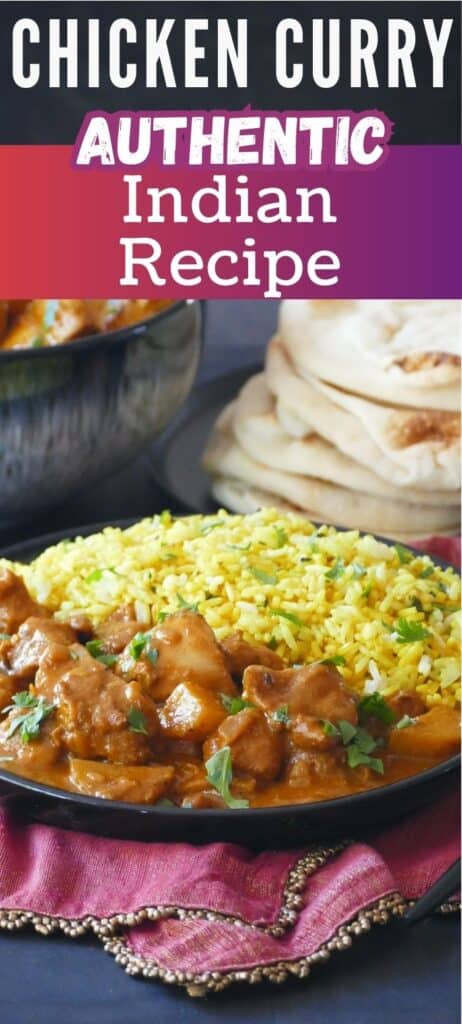




Leo says
This recipe starts with the words “AUTHENTIC Kerala chicken curry”
And then mentions “Low Sodium Chicken Broth” in the ingredients!
The contradiction doesn’t end there. It mentions “curry leaves” as optional! But most AUTHENTIC Kerala Style curries need curry leaves for that unique Earthy Taste!
And what’s more, the low sodium chicken broth, which authentic Keralites in Kerala never use to make their authentic curries, doesn’t have the “optional” tag against it!
Neena Panicker says
Hi Leo, curry leaves aren’t very easy to obtain for many Americans (who are a large percentage of my audience) hence, I say optional. They are highly recommended and I use them for most of my Kerala recipes. This is mentioned in the blog post, if you read through the tips section. Low sodium chicken broth can be substituted with water. I find that chicken broth adds more flavor than water. There are no hard and fast rules in cooking and every household adapts recipes to suit their needs and tastes, including “authentic Keralites”. We all adapt recipes based on ingredient availability,taste, and budget. I spend months in Kerala, and I consider myself pretty authentic 🙂
Marguerite says
Excellent recipe!
Made it with chicken thighs with bone . Used fresh tomatoes and added 3 green chilies but was not spicy . Didn’t add cashew or coconut but was delicious anyway. Thank you for this recipe.
Neena Panicker says
Marguerite, thank you for trying it out! I’m glad you enjoyed the Kerala style chicken curry!
SG says
Every recipe I’ve made of yours has been wonderful.
Paint the Kitchen Red says
Wow, that’s so kind of you. Thank you for trying them out!
Beck and Bulow says
This is amazing! My 10yo daughter is a picky easter, but will eat a whole breast on hey own when I cook this. Thank you so much for sharing this recipe.
Paint the Kitchen Red says
Thanks for your comment – I’m so happy to hear your daughter loves the recipe!
Shayne Varone says
This is perfect 👍
Paint the Kitchen Red says
Thank you, Shayne!
Jonathan says
I just made this last night, and I think it may be the best chicken curry I’ve ever tasted! (It’s certainly the best I’ve ever made).
Thank you so much for the recipe. Now I want to try all your other recipes too!
Paint the Kitchen Red says
Thank you so much, Jonathan! I’m so glad you like it.
Carmen says
The fifth ingredient is 3-4 “cloves”, but not sure what cloves are. I would like garlic cloves but garlic is also listed, hope the recipe turns out without this ingredient
Paint the Kitchen Red says
Carmen, cloves are used in many cuisines. Here an article about cloves. You should be just fine without it.
Esther says
I have heard that North and South have different India Garam Masala and they should not be used in recipes that are not from the same region. I’m wondering what kind of Garam Masala to use? Thanks for the recipe. Can’t wait to try this!! I loooooove curry!
Paint the Kitchen Red says
Hi Esther, you’re right in that there are many varieties of garam masalas. Some garam masalas include coriander and cumin and others don’t. When I make my own, I do not include coriander and cumin. Since this chicken curry recipe has both coriander and cumin, the extra from the garam masala won’t make a big difference. I think you’re safe with one that has most of the following ingredients: cinnamon, nutmeg, cloves, cardamom, mace. I also include anise seeds in my garam masala. Hope that helps! Let me know if you have further questions.
Erica Schmidt says
My mom cooks just like yours! Many times I have had to just watch her cook and write everything down myself. I am a true recipe follower, just the OCD in me I suppose. I love curry and can’t wait to try this dish! Pinning for later, thanks for sharing!
Paint the Kitchen Red says
It’s amazing, isn’t it, how they can just make the most delicious food just on the fly? I have to have my recipe in front of me, even if I’ve made the dish a million times! Let me know how it goes, Erica.
Joyce says
Whee! I am so excited to try this out! and I love love loooove that this is mom’s recipe. I always find those recipes are the well hidden best ones!
Thanks for the tip on the tomato paste as well! I never thought we could freeze it and I would always let it sit in the fridge (since most recipes call for just half a can) and then it goes to waste 🙁 and I hate wasting food and ingredients.
Your tips are so awesome!! 🙂
Thank you!
Paint the Kitchen Red says
You’re welcome Joyce – I really hope you get to try it, I think you’ll love it.
Romain says
This looks just like the curries I used to eat as a child! Mustard seeds, cinnamon and potatoes were in almost everything my parents cooked.
Paint the Kitchen Red says
And curry leaves, I bet!
Monica B says
This recipe is absolutely delicious! The best thing is that I had everything in my pantry except for the Indian mustard seeds and cinnamon stick. I substituted regular mustard seeds and about a 1/2 tsp of ground cinnamon. Still A+ with these substitutions. My family has requested that this make it into the weekly meal rotation. Thanks for sharing your family recipe with our family!
Paint the Kitchen Red says
So glad Monica! I am honored that you tried out my family recipe and it is now part of your family!
Heidi O'Donoghue says
Just made this recipe. It was fun and smelled delicious while cooking. Excited to share with my family for dinner this evening.
Paint the Kitchen Red says
I’m so glad you were able to try it Heidi. Hope they liked it! What did you serve with it?
Paffi S. Flood says
This recipe looks so yummy, and it seems simple to make. Love the photos showing each step. Can’t wait to try it.
Paint the Kitchen Red says
Let me know how it goes Paffi! Thanks for your feedback re: the step by step. I might try to post more recipes with the steps.